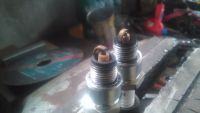Hello, I have a question about 126p elegant z97r. Well, I had no regulation of the idle speed at all, the screw was completely unscrewed. I was terribly irritated by this high speed so I decided to find another carburetor. I cleaned it, set the float, blew it, etc. I adjusted the valve clearance right away because there was good access. After installing the carburetor, I unscrewed the screw of the mixture composition, something about 1-1.5. I could not set it, the throttle cable was removed and the engine throttled and went out when the throttle was opened quickly. I came to this point that the engine was choking, but not going out. After covering about 15 km, the mass electrode was the color of light coffee with milk, but the metal housing inside was all black.
I noticed someone fiddling with the ignition. The roller position sensor relative to the original line and arrow was lowered. I found in parts another unmoved bracket and the arrow coincides with the line, but now when adjusting the carburetor, the mixture composition adjustment screw reacts only after unscrewing 1mm from a full turn, I will do about max 1.2 revs and the engine speed drops and the engine goes out (although it is said that when adjusting, unscrew 1-1.5 revs and adjust), for me it is maybe 1 revolution unscrewed, but the engine continues to choke. It smokes heavily in the cold. Black smoke is visible when gassing. It does not hit the rpm, and after driving 10 km, the candles are black, i.e. too much fuel pounds, or does not burn. What to do?? Look for another carburetor ?? Ps. I made the adjustment on a warm engine with the air filter on. Once I touched the carburetor elbow with my hand to turn off the engine, surprisingly, the engine did not go down, the revs decreased and that's all about it, I was sure there was left air, I unscrewed the elbow and started the car and put my hand on the carburetor and immediately went out and felt gas on my fingers, I did the same with the foil and after applying it went out, so apparently the elbow or the carburetor is not even because it catches the left air, although I changed the seals for new ones.
Checked:
New candles with a gap of 0.7 mm from the electrode
new wires
The carburetor cleaned, changed O-ring on the mixture change screw,
Changed sensor support in which the arrow coincides with the dash,
New air filter
New fuel filter.
fresh fuel.
Nanoplex blue.
I have a solenoid valve, but the old idle nozzle is unscrewed and inserted.
There is also a vacuum sensor, which is probably connected, but there is no hose going to the carburetor base because the base is of the old type without outlets.
On the old carburetor, which had a high idle speed, the candles were rust, dark rust, but he did not have much power and sometimes he burned 8 9 liters. then I did 240km on one tank and decided to do something about it, but as you can see the problems themselves arose.
I am asking for your understanding
I noticed someone fiddling with the ignition. The roller position sensor relative to the original line and arrow was lowered. I found in parts another unmoved bracket and the arrow coincides with the line, but now when adjusting the carburetor, the mixture composition adjustment screw reacts only after unscrewing 1mm from a full turn, I will do about max 1.2 revs and the engine speed drops and the engine goes out (although it is said that when adjusting, unscrew 1-1.5 revs and adjust), for me it is maybe 1 revolution unscrewed, but the engine continues to choke. It smokes heavily in the cold. Black smoke is visible when gassing. It does not hit the rpm, and after driving 10 km, the candles are black, i.e. too much fuel pounds, or does not burn. What to do?? Look for another carburetor ?? Ps. I made the adjustment on a warm engine with the air filter on. Once I touched the carburetor elbow with my hand to turn off the engine, surprisingly, the engine did not go down, the revs decreased and that's all about it, I was sure there was left air, I unscrewed the elbow and started the car and put my hand on the carburetor and immediately went out and felt gas on my fingers, I did the same with the foil and after applying it went out, so apparently the elbow or the carburetor is not even because it catches the left air, although I changed the seals for new ones.
Checked:
New candles with a gap of 0.7 mm from the electrode
new wires
The carburetor cleaned, changed O-ring on the mixture change screw,
Changed sensor support in which the arrow coincides with the dash,
New air filter
New fuel filter.
fresh fuel.
Nanoplex blue.
I have a solenoid valve, but the old idle nozzle is unscrewed and inserted.
There is also a vacuum sensor, which is probably connected, but there is no hose going to the carburetor base because the base is of the old type without outlets.
On the old carburetor, which had a high idle speed, the candles were rust, dark rust, but he did not have much power and sometimes he burned 8 9 liters. then I did 240km on one tank and decided to do something about it, but as you can see the problems themselves arose.
I am asking for your understanding




